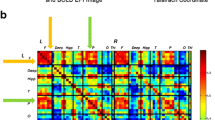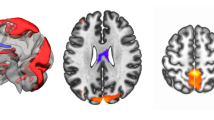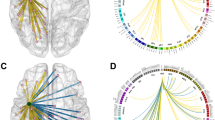Abstract
Purpose
Gliomas are the most common primary brain tumor. Currently, topological alterations of whole-brain functional network caused by gliomas are not fully understood. The work here clarified the topological reorganization of the functional network in patients with unilateral frontal low-grade gliomas (LGGs).
Methods
A total of 45 patients with left frontal LGGs, 19 with right frontal LGGs, and 25 healthy controls (HCs) were enrolled. All the resting-state functional MRI (rs-fMRI) images of the subjects were preprocessed to construct the functional network matrix, which was used for graph theoretical analysis. A two-sample t-test was conducted to clarify the differences in global and nodal network metrics between patients and HCs. A network-based statistic approach was used to identify the altered specific pairs of regions in which functional connectivity in patients with LGGs.
Results
The local efficiency, clustering coefficient, characteristic path length, and normalized characteristic path length of patients with unilateral frontal LGGs were significantly lower than HCs, while there were no significant differences of global efficiency and small-worldness between patients and HCs. Compared with the HCs, betweenness centrality, degree centrality, and nodal efficiency of several brain nodes were changed significantly in patients. Around the tumor and its adjacent areas, the inter- and intra-hemispheric connections were significantly decreased in patients with left frontal LGGs.
Conclusion
The patients with unilateral frontal LGGs have altered global and nodal network metrics and decreased inter- and intra-hemispheric connectivity. These topological alterations may be involved in functional impairment and compensation of patients.




Similar content being viewed by others
Data Availability
The anonymized imaging database can be obtained after the reasonable request is evaluated and approved by the Ethics Committee of Huashan hospital, Fudan University.
References
Davis ME (2018) Epidemiology and overview of gliomas. Semin Oncol Nurs 34:420–429
Ostrom QT, Bauchet L, Davis FG et al (2014) The epidemiology of glioma in adults: a “state of the science” review. Neuro Oncol 16:896–913
Brain GBD, Other CNSCC (2019) Global, regional, and national burden of brain and other CNS cancer, 1990–2016: a systematic analysis for the Global Burden of Disease Study 2016. Lancet Neurol 18:376–393
Duffau H (2014) Diffuse low-grade gliomas and neuroplasticity. Diagn Interv Imaging 95:945–955
Lv K, Cao X, Wang R et al (2022) Neuroplasticity of glioma patients: brain structure and topological network. Front Neurol 13:871613
Bouwen BLJ, Pieterman KJ, Smits M, Dirven CMF, Gao Z, Vincent A (2018) The impacts of tumor and tumor associated epilepsy on subcortical brain structures and long distance connectivity in patients with low grade glioma. Front Neurol 9:1004
Liu D, Chen J, Hu X et al (2020) Contralesional homotopic functional plasticity in patients with temporal glioma. J Neurosurg. https://doi.org/10.3171/2019.11.JNS191982:1-9
Lv K, Cao X, Wang R et al (2023) Contralesional macrostructural plasticity in patients with frontal low-grade glioma: a voxel-based morphometry study. Neuroradiology 65:297–305
van den Heuvel MP, Sporns O (2019) A cross-disorder connectome landscape of brain dysconnectivity. Nat Rev Neurosci 20:435–446
Bullmore E, Sporns O (2009) Complex brain networks: graph theoretical analysis of structural and functional systems. Nat Rev Neurosci 10:186–198
Louis DN, Perry A, Wesseling P et al (2021) The 2021 WHO Classification of tumors of the central nervous system: a summary. Neuro Oncol 23:1231–1251
Fox MD, Zhang D, Snyder AZ, Raichle ME (2009) The global signal and observed anticorrelated resting state brain networks. J Neurophysiol 101:3270–3283
Korgaonkar MS, Fornito A, Williams LM, Grieve SM (2014) Abnormal structural networks characterize major depressive disorder: a connectome analysis. Biol Psychiatry 76:567–574
Wang YF, Gu P, Zhang J et al (2019) Deteriorated functional and structural brain networks and normally appearing functional-structural coupling in diabetic kidney disease: a graph theory-based magnetic resonance imaging study. Eur Radiol 29:5577–5589
Zalesky A, Fornito A, Bullmore ET (2010) Network-based statistic: identifying differences in brain networks. Neuroimage 53:1197–1207
Huang Q, Zhang R, Hu X et al (2014) Disturbed small-world networks and neurocognitive function in frontal lobe low-grade glioma patients. PLoS ONE 9:e94095
Xu H, Ding S, Hu X et al (2013) Reduced efficiency of functional brain network underlying intellectual decline in patients with low-grade glioma. Neurosci Lett 543:27–31
Park JE, Kim HS, Kim SJ, Kim JH, Shim WH (2016) Alteration of long-distance functional connectivity and network topology in patients with supratentorial gliomas. Neuroradiology 58:311–320
Achard S, Salvador R, Whitcher B, Suckling J, Bullmore E (2006) A resilient, low-frequency, small-world human brain functional network with highly connected association cortical hubs. J Neurosci 26:63–72
Kaiser M, Martin R, Andras P, Young MP (2007) Simulation of robustness against lesions of cortical networks. Eur J Neurosci 25:3185–3192
Hart MG, Price SJ, Suckling J (2016) Connectome analysis for pre-operative brain mapping in neurosurgery. Br J Neurosurg 30:506–517
De Pauw R, Aerts H, Siugzdaite R et al (2020) Hub disruption in patients with chronic neck pain: a graph analytical approach. Pain 161:729–741
Mano H, Kotecha G, Leibnitz K et al (2018) Classification and characterisation of brain network changes in chronic back pain: a multicenter study. Wellcome Open Res 3:19
Qi C, Wang R, Meng L, Li S, Li Y (2022) Functional reorganization of contralesional networks varies according to isocitrate dehydrogenase 1 mutation status in patients with left frontal lobe glioma. Neuroradiology 64:1819–1828
Jutten K, Mainz V, Delev D et al (2020) Asymmetric tumor-related alterations of network-specific intrinsic functional connectivity in glioma patients. Hum Brain Mapp 41:4549–4561
De Baene W, Rutten GJM, Sitskoorn MM (2017) The temporal pattern of a lesion modulates the functional network topology of remote brain regions. Neural Plast 2017:3530723
Fang S, Li L, Weng S et al (2022) Decreasing shortest path length of the sensorimotor network induces frontal glioma-related epilepsy. Front Oncol 12:840871
de Jongh A, de Munck JC, Baayen JC, Puligheddu M, Jonkman EJ, Stam CJ (2003) Localization of fast MEG waves in patients with brain tumors and epilepsy. Brain Topogr 15:173–179
Vincent JL, Patel GH, Fox MD et al (2007) Intrinsic functional architecture in the anaesthetized monkey brain. Nature 447:83–86
Di G, Tan M, Xu R et al (2022) Altered structural and functional patterns within executive control network distinguish frontal glioma-related epilepsy. Front Neurosci 16:916771
Liu D, Hu X, Liu Y et al (2019) Potential intra- or cross-network functional reorganization of the triple unifying networks in patients with frontal glioma. World Neurosurg 128:e732–e743
Liu Y, Hu G, Yu Y et al (2020) Structural and functional reorganization within cognitive control network associated with protection of executive function in patients with unilateral frontal gliomas. Front Oncol 10:794
Tordjman M, Madelin G, Gupta PK et al (2021) Functional connectivity of the default mode, dorsal attention and fronto-parietal executive control networks in glial tumor patients. J Neurooncol 152:347–355
Belleville S, Clement F, Mellah S, Gilbert B, Fontaine F, Gauthier S (2011) Training-related brain plasticity in subjects at risk of developing Alzheimer’s disease. Brain 134:1623–1634
Ocklenburg S, Friedrich P, Gunturkun O, Genc E (2016) Voxel-wise grey matter asymmetry analysis in left- and right-handers. Neurosci Lett 633:210–214
Avramescu-Murphy M, Hattingen E, Forster MT et al (2017) Post-surgical language reorganization occurs in tumors of the dominant and non-dominant hemisphere. Clin Neuroradiol 27:299–309
Funding
This work was supported by the National Natural Science Foundation of China (82372048), Research Startup Fund of Huashan Hospital, Fudan University (2021QD035), Shanghai Sailing Program (22YF1405000), Shanghai Municipal Commission of Science and Technology (22TS1400900, 23S31904100, 22ZR1409500, and 22S31905300), and Greater Bay Area Institute of Precision Medicine (Guangzhou) (KCH2310094).
Author information
Authors and Affiliations
Corresponding authors
Ethics declarations
Conflict of interest
The authors declare that they have no conflict of interest.
Ethics approval
All procedures performed in the studies involving human participants were in accordance with the ethical standards of the institutional and/or national research committee and with the 1964 Helsinki Declaration and its later amendments or comparable ethical standards.
Informed consent
Informed consent was obtained from all individual participants included in the study.
Additional information
Publisher's Note
Springer Nature remains neutral with regard to jurisdictional claims in published maps and institutional affiliations.
Kun Lv and Yue Hu contributed equally to this work.
Supplementary information
Below is the link to the electronic supplementary material.
Rights and permissions
Springer Nature or its licensor (e.g. a society or other partner) holds exclusive rights to this article under a publishing agreement with the author(s) or other rightsholder(s); author self-archiving of the accepted manuscript version of this article is solely governed by the terms of such publishing agreement and applicable law.
About this article
Cite this article
Lv, K., Hu, Y., Cao, X. et al. Altered whole-brain functional network in patients with frontal low-grade gliomas: a resting-state functional MRI study. Neuroradiology 66, 775–784 (2024). https://doi.org/10.1007/s00234-024-03300-7
Received:
Accepted:
Published:
Issue Date:
DOI: https://doi.org/10.1007/s00234-024-03300-7




